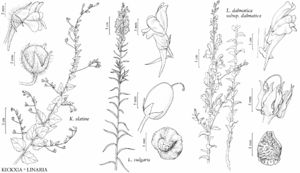Linaria dalmatica subsp. dalmatica
Bracts usually ± equal to or longer than fruiting pedicels. Pedicels 3–8 mm in flower, 4–10(–13) mm in fruit. Calyx lobes ovate to lanceolate, 3–9 × 1–3.5 mm in flower, 4–10(–13) × 1.5–5 mm in fruit. Corollas (27–)28–38(–42) mm; spurs straight or curved, 11–24 mm, shorter, subequal to, or longer than rest of corolla. 2n = 12.
Phenology: Flowering Apr–Sep.
Habitat: Roadsides, disturbed places, railroad rights-of-way, lawns, waste grounds, stream banks, rangelands, croplands, pastures, yellow-pine forests, pinyon/juniper woodlands, sagebrush scrub, usually well-drained soils.
Elevation: 0–3100 m.
Distribution
Alta., B.C., Man., N.B., Nfld. and Labr. (Nfld.), N.S., Ont., Que., Sask., Yukon, Ariz., Calif., Colo., Conn., Idaho, Ill., Ind., Kans., Maine, Mass., Mich., Minn., Mont., Nebr., Nev., N.H., N.Mex., N.Dak., Ohio, Okla., Oreg., Pa., R.I., S.C., S.Dak., Utah, Vt., Wash., Wyo., Europe, sw Asia, introduced also in s South America (Argentina), Australia.
Discussion
Hybrids between subsp. dalmatica and Linaria vulgaris are known as L. ×hybrida Schur; see under 1. L. vulgaris.
Selected References
None.
